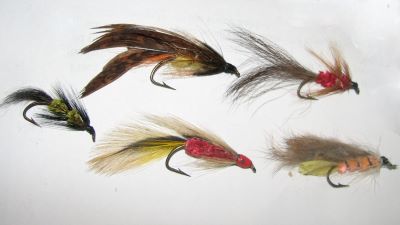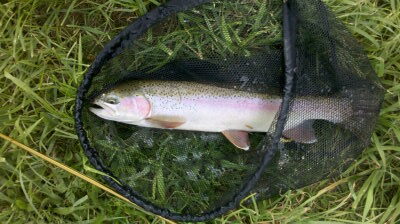Stock trout are not like wild fish. That is because they spent their entire life feeding upon pellets. A natural fly or nymph in their hatchery pond will be an extremely uncommon sight. So when a stock trout is hungry, they do not think of a crunchy mayfly or juicy worm, but rather a small round brownish grey pellet. That is their food, that is their prey.
It might not sound that sporting, but the best way to catch recently stock trout on the fly rod is not with a hyper realistic fly, but a fly which resembles a pellet.
Other flies which work well are round fish egg imitations. Pellets might be the only food which stock trout know, but they still have instincts. So a brightly colored, flashy streamer with plenty of movement is still likely to grab their attention.
How to catch stock trout on dry flies?
So, stock trout eat pellets. Why would they eat a dry fly? Well, firstly stock trout feed upon pellets which drop down from above. They are use to swallowing pellets even off the surface. So Surface feeding is not unfamiliar for them.
Secondarily, depending on where in the country you live. Some stock trout have been breed in such a way to have a preference for surface feeding. This was down, to make them easier to catch while fly fishing.
These two factors combine, means stock trout can usually be caught on a dry fly. My suggestion is to go big, use a dry fly with a big round body. The classic Stimulator pattern works well.
Dead drifting the dry fly often works, but even a few wiggles and twitches across the surface can certainly spark interest.
The four best types of flies to catch stock trout
- Pellet imitation fly
- Fish egg imitation fly
- Bright, wiggly streamer
- Large body dry fly

Presentation is still important when targeting stock trout.
For best, and most consistent results will want to present the fly about a foot or two off the bottom, that is the depth that stock trout usually swim. Placing a piece of split shot, about two feet behind the fly is one way to control the depth. Cast out, allow the split shot to sink too the bottom dragging the fly with it. The fly then will float slightly off the bottom hopefully catching the attention fish feeding nearby. Retrieve it back in every so slowly. This is a game of patience rather than speed.
An alternative to split shot, is to use a two fly rig. Use a weighted egg or streamer in the bottom position, and a couple of feet up fish a slightly buoyant egg or pellet imitation.
The longer the trout have been in the pond, the more acclimatised they become.
The longer the trout have been in the pond, the more use to wild food they become. Out of hunger, they start tasting and eating almost anything which might be food. It is not uncommon for stock trout to have stomachs full of leafs, sticks and slime as they gobble up anything floating by.
Stockies might seem dumb, but that is because they are ignorant of the world outside their hatchery pool. They are actually very quick learners with deeply ingrained instincts. These combined with a lot of trail and error, means stock trout quickly start to recognize natural prey.
A few days after stocking, these trout are not usually difficult to catch on more natural looking patterns even through they might still favor pellet imitations.
How important is stealth when targeting stock trout?
Stock trout grow up around people, at first the sight of a person means feeding time, rather than danger. This is the reason why stock trout, usually Rainbows and Cutthroats are not at all afraid. Sometimes they even swim right up to us to feed in the trail of debris kicked up by our wading.
So, while the trout might not be scared of us. It does not mean we can charge towards them like a pack of bloodhounds after a boar. Any violent, sudden or unexpected movement can still spook them. A fly line splashing down hard, could just as easily be an eagle swooping down to grab a feed. The stock trout does not know that, the stock trout probably does not even know eagles are hunting them. But they do still know danger comes from above, and any unexpected disturbance means danger.
So, when at the lake. Move slowly and carefully. Avoid sudden movements and unnecessary splashing. Keep the number of casts to a minimum, do not use your fly line to whip the pond surface into a foam.

